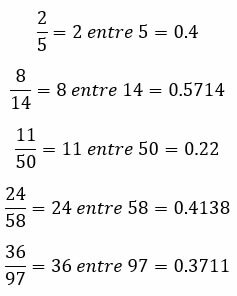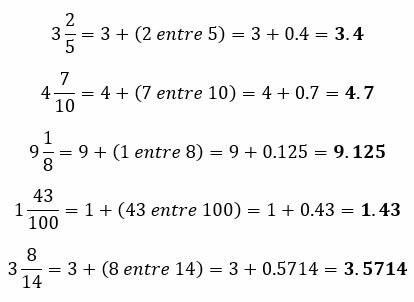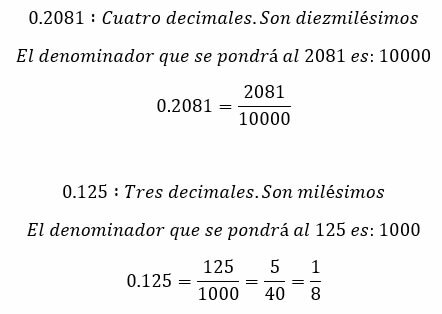Fraction Conversion Example
Math / / July 04, 2021
The fractions are values that do not complete the unit (the integer: 1), and are written with a numerator and a denominator. The two ways of expressing numerical values are the fractions and decimal numbers. It is possible to convert one to another and vice versa, to solve mathematical operations with them.
Conversion of fractions
When we talk about conversion of fractions, we can refer to two different situations:
- Converting fractions to decimal number
- Converting a decimal number to fractions
- It may interest you: Fractions.
Example of Converting Fractions to Decimal Numbers
To convert a fraction (proper or improper) into a decimal number, you just have to divide: numerator by denominator.
In the proper fractions, the value does not complete the unit (numerator less than the denominator), so it will start with a 0 (zero). Write the decimal point and to its right the rest of the resulting value.
For example:

In the improper fractions, the value exceeds the unit (numerator greater than the denominator), so the result will have a whole number, followed by the point and the rest of the decimal part.
For example:

In the mixed fractions, we already have the whole part; so we only divide numerator by denominator, from the proper part. When the division is resolved, only the values are added: whole part plus decimal part.
For example:

Example of Converting a Decimal Number to Fractions
Decimal numbers are governed by a base of submultiples of 10. Converting decimal numbers to fractions consists of the following steps:
- Observe the order of the decimal number, that is, if it reaches the tenths (1 decimal), the hundredths (2 decimal places), the thousandths (3 decimal places), etc.
- Drink the number on the rightOf the point
- A denominator is placed on that number: a multiple of 10, which will be according to the number of digits it has: if it has 1, the denominator is 10. If you have 2, the denominator is 100. If you have 3, the denominator is 1000.
For example:


As has been done in the last case, the fractions that have the denominators of multiples of 10 can be simplified, transforming them into equivalent fractions with simpler numbers.
Now you know how to correctly convert fractions to decimal numbers and vice versa.
Keep reading:
- Proper fractions
- Improper fractions
- Mixed fractions

